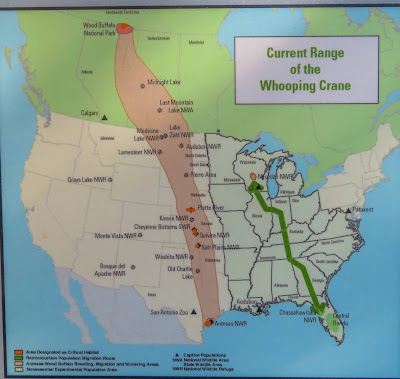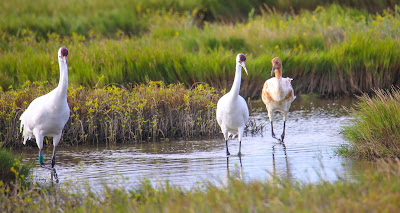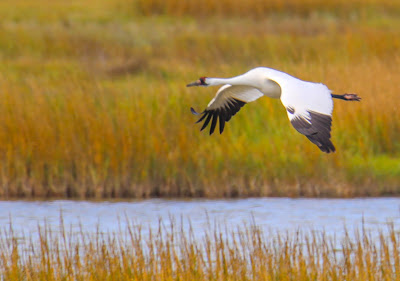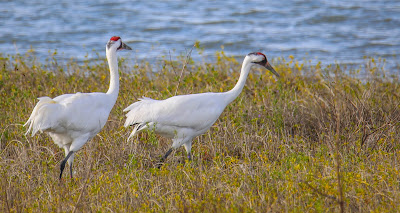The whooping crane population was down to 21 wild birds and 2 captive birds in 1941. There are now more than 800 living whooping cranes, the tallest bird in North America and we recently visited Aransas NWR in Texas where the vast majority of them winter. The whooping crane can be as tall as 5 feet, 3 inches and its wingspan can reach 7 feet, 7 inches.
Adult whooping cranes are white with a red crown and mustache stripe, yellow eyes, a long, dark, pointed bill and black legs.
They fly with legs and neck extended and black wing tips that are only visible in flight.
Immature whooping cranes are white with a rusty brown head and mottled back.
Their loud calls, for which they are named, can be heard for more than a mile.
 |
| These whoopers began calling when we were quite close and it was loud and magical. |
Most of them spend the summer and lay their eggs and hatch chicks in the Wood Buffalo NP in the Northwest Territories of Canada. About 75% of them have a migratory stopover in Salt Plains NWR in Oklahoma and the breeding populations winter along the Gulf Coast of Texas.
 |
| The tan stripe shows the migratory route of the vast majority of whoopers. Note Aransas NWR at the southern tip of their range. |
In an effort to protect the species in the event of a catastrophic event, such as a hurricane, that could wipe out the species, efforts are being made to introduce them to new areas, including Necedah NWR in central Wisconsin, as an alternate summer range, and Florida for migratory and non-migratory birds and Louisiana for non-migratory birds.
In their Texas wintering grounds they favor crustaceans, mollusks, fish, small reptiles and aquatic plants. Several studies at Aransas NWR showed that blue crabs were 90% of their energy intake during the winter.
 |
| This whooper is eating some sort of large water insect or crab. |
 |
| This whooper is eating berries. |
During the summer they enjoy frogs, small rodents, small birds, crayfish, clams, snails, aquatic insects, aquatic tubers and berries.
Early on a Friday morning in late November we drove to Aransas NWR. It was chilly and Judy stayed in the car while I took the 1.4 mile roundtrip Heron Flats Trail. As I was near the end of the trail and on my way back, I encountered a woman that told me she thought she could see some whooping cranes. She walked a short distance and showed me two large white birds quite a distance away, across a water channel and on a small island. They were not gray, so they were not sandhill cranes, so we determined that they must be whooping cranes. They were making a racket. I nudged out into the swampland beyond the trail about 30 yards in order to get better photos and got my sandaled feet wet and muddy, but got much better photos.
 |
| I could hear the whoopers making noise even as I got back to my car more than a half mile away. |
Later in the day we took a Whooping Crane and Coastal Birding Tour with Rockport Birding and Kayak Adventures out of Rockport, Texas, along with about 35 other people on a large boat across Aransas Bay and into the Aransas NWR. We saw 30 whooping cranes during the course of our three hour tour, with the last sighting being the very best: an immature whooper with its parents that got within about 20 yards of our boat! Our guide, who has been doing these tours for years, said that there were about 500 whoopers in Aransas NWR last year and he is anticipating about 550 this year. He was giddy about the number of immature whoopers we saw on our excursion - it must have been 5 or 6 and we were early in the wintering cycle.
I share some more of my photos below:























This experience was one of those "we may never pass this way again" moments. What incredible, distinctive birds, and HOW do they hide those black wing tips when they are standing? And is that where "wing-tip shoes" got their name?
ReplyDelete